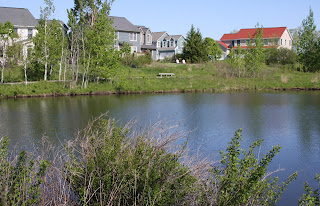“The radishes planted in northwest Ohio go in about this time of year and are left in the ground to die, explained our host, Allen Dean. Planting doomed radishes, it turns out, is an innovative technique he has used in recent years to improve soil nutrients and reduce runoff from his Williams County farm.Here’s the basics on how it works: Farmers plant seeds for a plant called an oilseed radish. It doesn’t actually have to be that plant, but it needs to grow a foot or longer into the soil during the fall in a tubular shape, like a carrot or a parsnip. It also needs to grow a fair amount of foliage up on the ground. Radishes are usually more affordable.It’s important that the plant drill down into the soil so that when it dies, usually during a mid-January freeze, it decays and leaves behind a v-shaped hole for snow and water to penetrate deeper. The decayed radishes Dean showed us looked like organic socks.Oilseed radishes are particularly good at absorbing nutrients from the surface and sending them down into the soil as the tubular plant drills it way into the ground.”
Category:
A delicious solution to Great Lakes algae issues?
September 25th, 2012 by Irene MilesEcosystem restoration takes a big effort and big engineering
July 12th, 2012 by Irene Miles“The USACE works to restore degraded ecosystems to a more natural condition through large-scale ecosystem restoration projects, such as the Comprehensive Everglades Restoration, Louisiana Coastal Area Ecosystem Restoration, Chesapeake Bay Oyster Recovery, Aransas National Wildlife Refuge Beneficial Use of Dredged Material (restoration of marsh critical to the endangered Whooping Crane), and Houston Ship Channel Beneficial Use of Dredged Material (marsh restoration in Galveston Bay), and by employing system-wide watershed approaches to problem solving and management for smaller ecosystem restoration projects.”
Local water travels a long, long way
June 25th, 2012 by Irene MilesWatersheds are areas where water comes together and drains to a common place. In addition to the streams and rivers and creeks that we can see, though, watersheds encompass a huge range of pathways for water, and your nearby water supply might be part of a very large system that spans multiple states.
“Of course, obtaining sustainable development in town isn’t enough, in and of itself, to guarantee high quality, fishable and swimmable rivers and streams. Industry plays a part; utilities and waste water treatment plants play a part; sensitive farming, ranching, and/or timbering play a part, all in different proportions depending upon the particular watershed in question.”
Recent News
- New step-by-step guide and veterinary brochures expand UnwantedMeds.org resources
- The Helm magazine features teachers and scientists setting sail on Lake Michigan
- The Know Your H₂O Kit gets a real-world lab test by middle schoolers
- IISG has a long history of supporting teachers through Great Lakes activities and resources
- Join Sea Grant to oversee program research and reporting
IISG Instagram
This Halloween, we’re diving into the eerie depths of the Great Lakes.
Each lake has its own spooky story:
🕯️ Lake Superior hides ghost ships beneath its icy waves...
🦴 Lake Michigan whispers tales of vanishing beaches…
🌉Lake Huron hides prehistoric hunting camps on a lake bottom ridge...
🧪 Lake Erie bubbles with algal blooms that glow like potions...
🦠 Lake Ontario was first to host strange creatures like the blood sucking sea lamprey.
Never fear, we have resources to help you make these fascinating topics less frightening at iiseagrant.org/education.

IISG is seeking a talented and passionate person to join our team as a research & reporting administrator. This is an exciting leadership opportunity for someone interested in managing a competitive research portfolio and leading our annual reporting process to make a real impact on the health and vitality of our Great Lakes ecosystems and communities.
The successful candidate will be responsible for overseeing our research competitions, spearheading data collection and reporting for our ~$5 million program, and supervising a small team of dedicated staff.
Interested? Learn more at the link in bio.

Just in time for DEA National Takeback Day on October 25, Unwanted Meds now has an interactive step-by-step guide that walks users through how to properly dispose of different types of medicine. Users can also find two new educational brochures designed to help veterinarians, pet owners, and livestock farmers prevent accidental poisonings and pollution.
Learn more at the link in bio.

Join us November 5th and November 12th seminars on the latest fish biology, ecology, and fisheries science happening in Lake Michigan.
Topics will include:
• PFAS contamination in coastal tributaries
• Great Lakes Spawning Whitefish and Invasive Mussels (SWIM) project
• Hatchery update from the Indiana Department of Natural Resources
Learn more and register at the link in bio.

Categories
- Aquaculture
- Aquatic Invasive Species
- Buoys
- Climate Ready Communities
- Coastal Resilience
- Director's Blog
- Education
- Featured
- Fellowships
- Fisheries
- Funded Research
- Funding
- Great Lakes Cleanup
- Great Lakes Data
- Healthy Waters
- Internships
- Jobs
- K-12 Education
- News
- Photos
- Program
- Recreation & Tourism
- Resources
- Sea Grant Scholars
- Stormwater & Green Infrastructure
- Sustainable Community Planning
- The Helm
- Uncategorized
- Video
- Water Resource Economics

